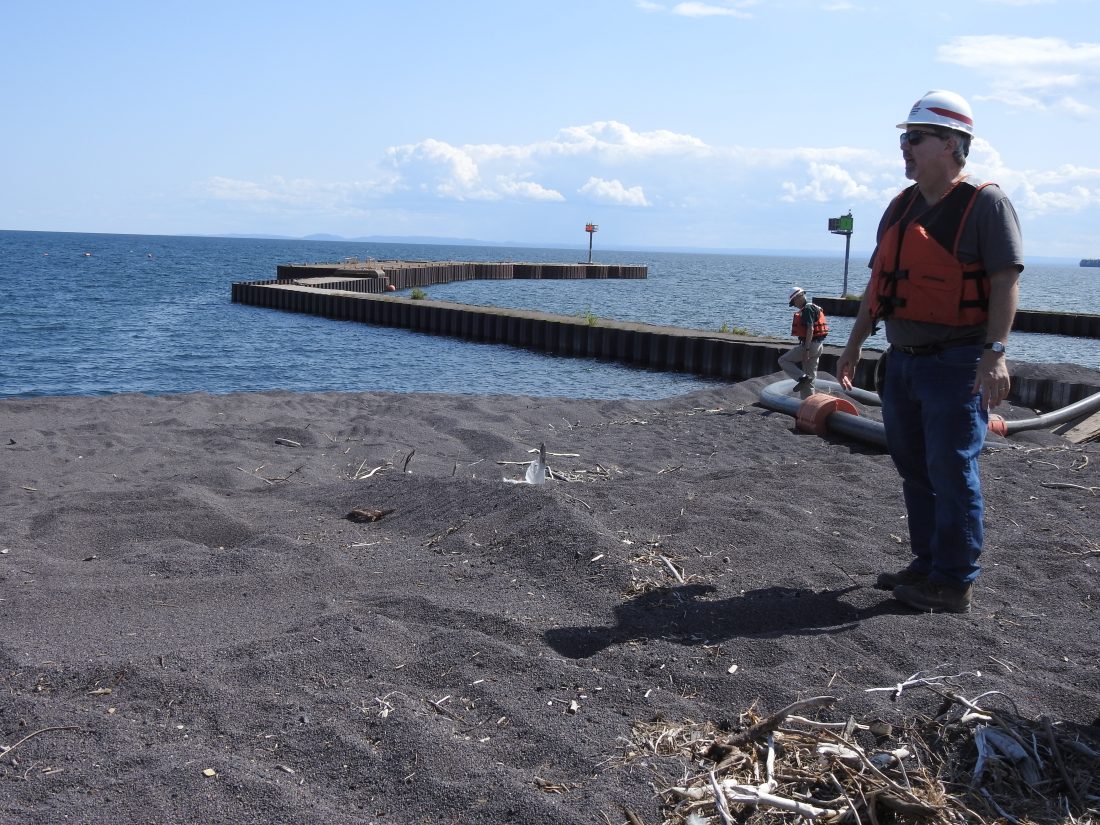EPA Great Lakes official visits drifting stamp sands

Chris Korleski, director of the Environmental Protection Agency’s Great Lakes National Program Office, looks at some of the 15 million cubic yards of stamp sand drifting from Gay to the Grand Traverse Harbor from a harbor breakwall during a recent tour. (Houghton Daily Mining Gazette photo by Garrett Neese)
SCHOOLCRAFT TOWNSHIP — Over the past 100 years, stamp sands have slowly migrated from a pile at Gay 5 miles to the Grand Traverse Harbor.
A delegation including an Environmental Protection Agency official traced the sands’ path in reverse during a tour of sites Thursday.
In addition to the dredging operation at the harbor, the group visited a spoils placement area upstream, as well as the original deposit site in Gay.
“You can look at photographs, you can look at really accurate maps, you can talk to people, but without standing here, without being on top of those piles, I wouldn’t have a feeling for the magnitude here,” said Chris Korleski, director of the EPA’s Great Lakes National Program Office.
Meeting with other people involved in the project is also important, Korleski said. Members of several organizations involved in the project took part in the tour, fielding questions from Korleski and telling him about the importance of the project.
Those sands, waste products of copper processing at the Mohawk and Wolverine mines, have since covered almost 1,500 acres of shoreline and lake bottom.
At times, it has threatened to cut off access to the harbor, a popular point for recreational fishing. It has also encroached on Buffalo Reef, a 2,200-acre reef where lake trout and whitefish spawn. Estimates have put the amount of unusable space on the reef at 35 percent.
The waters within 50 miles of the reef are responsible for almost a quarter of the lake trout caught in Lake Superior each year.
“Even though the project may take many, many years, we are committed to it, because we’re looking to the future,” said Evelyn Ravindran, natural resources director for the Keweenaw Bay Indian Community.
The EPA has provided $3.7 million in Great Lakes Restoration Initiative (GLRI) funds to the U.S. Army Corps of Engineers to remove stamp sands in the harbor. A dredging project is underway this summer, removing about 157,000 cubic yards of stamp sand. It is intended to buy time for the harbor and reef while the task force decides on a long-term plan.
Earlier this year, the task force settled on three preferred alternatives. Those are maintenance dredging at the harbor and an underwater trough area, with the sands contained by a stone revetment; dredging the area and disposing the stamp sands in a newly built landfill nearby; and dredging 15 million cubic yards of stamp sands to be deposited in the White Pine mine tailings basin.
Korleski said the EPA has not given a preference.
“I have a general awareness of what those alternatives are,” he said. “But I think there needs to be a lot more discussion about feasibility, about costs, about all the things you have to think about before you can decide, ‘OK, this really makes the most sense.'”

